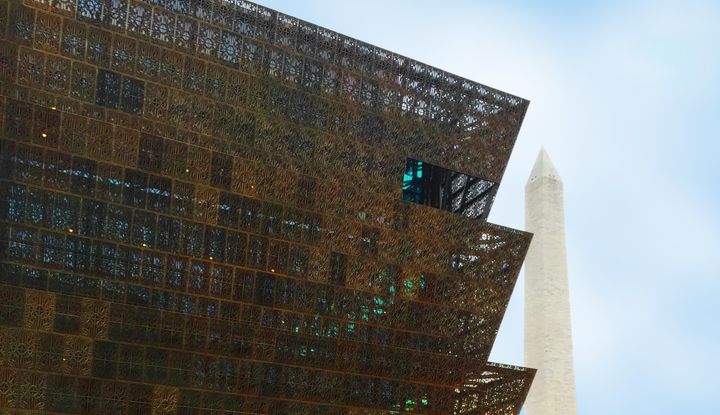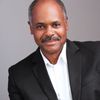
National Museum of African American History and Culture & The Washington Monument
I am standing on the National Mall where the ancestry of my people has built a home. The National Museum of African American History and Culture rises, gracious and majestic before me. As I move toward the doors, I can’t help reflecting upon the fact I am in the land of the free and the brave which is at the moment burdened by and shrouded in the specter of unadulterated bigotry, hatred and intolerance. Even so, and strangely enough to some, I find my safe zone and I smile. As an African American son of the south, I am practiced at living the best I can amid such contempt.
But it is finally here. After all the years of raising two children in this city, trying to help them find themselves in the treasured museums of the Smithsonian, it is here. Not a museum about Africa or piecemeal exhibits about us. But something full, real and as complete as a good Sunday supper. Once inside, I am stunned by this building and all that it holds. It’s like someone laid out the strands of my DNA all around me. I think about what this building would have meant to me as a child.
I follow along with my wife, Jeanne, and our friends Dabney and Joe. Joe’s company has created several of the films on display and many of the interactive exhibits. He knows his way around and we follow our personal docent. And there is so much to see. Some pleasing. Much of it painful. Somewhere between Chuck Berry’s red Cadillac and Emmett Till’s coffin, I get filled up. Somewhere between the shackles of shameful bondage and a display celebrating our first family, I get proud. At the end of one hallway, Muhammad Ali is shouting, “I shook up the world!”
At one point, we pass a group of people standing by a window, pointing outside toward the stage and grounds where the opening ceremonies took place. For a moment, I think that would have been nice, but then I change my mind. After decades in the journalism business, I have learned to look beyond the obvious. I think that while the celebrities and the president helped to bring appropriate attention to the creation and opening of this museum, the real story was unveiling itself before me in the eyes of the regular folk making their way through the exhibits.
There, on the ramp, an old man in a wheel chair is being pushed by a loved one. The ramp is crowded but he doesn’t notice. He has on a ball cap with what looks to be some kind of faded military emblem on it. He stares up at the training plane once flown by Tuskegee Airmen, hanging high above him. Maybe the look on his face is full of memories. Maybe just full of being so close to the men who fought for the chance to fly and fight for their country. A country that did not welcome them home. As he’s pushed closer to me, I have the urge to reach out and touch his hand. I want to just smile at him and share the moment, but in the end, I decide not to disturb him. Somehow, I don’t feel worthy.
Joe stops before one of the films he’s made. It’s a massive work projected on a wall across from the landing on which we stand. The video is impacted by the graininess of the cement wall. Like wrinkles on a face, adding depth and texture to the heroes on display. As pictures dissolve from one to another I overhear two women standing close to me, loudly and proudly identifying the people represented. I think they are together until one leaves and the other stays behind, speaking aloud to herself the names of people like James Baldwin, Fredrick Douglass, and more. Finally, she gets to Sojourner Truth. And when she says the name her voice cracks. I can’t look at her. It’s enough to feel what’s in the sound of her voice. Sista to Sista. Across time.
Finally, we end up in a room looking at a film in 360 degrees. All around me black people are huge and living their lives amid the contempt. And it isn’t just famous people but everyday people doing everyday things. People who look amazing and exceptionally powerful. They just look bold, confident and free. Finally, I am overcome. I say, “I have never seen us - black people - on a scale like this. I don’t know how to put it, except to say it’s like our Mt. Rushmore.” I try to explain it better by asking them to imagine people, from another planet even, who didn’t know our country or its history. I imagine that after seeing this museum and this film they would walk outside and see a rich and proud people and point at us in awe. They would never expect a people like that could be shot down unarmed in a city street.
I look at Dabney, who is white, to see if she understands. She puts her hand on my arm and tells me that she understands slavery and its legacy. She understands the unfairness of systemic racism. She knows it’s wrong. She feels like she understands the importance of the museum. Still she says, “Jeffrey, I could never see or feel what you are explaining to me now. I couldn’t have reached what you are feeling right now. That’s why I’m glad I’m here with you today.”
In the cab, I’m still thinking about the visit. I’m thinking about the absolute sea of black faces which makes me smile. I’m thinking about the black woman who collided with Dabney in the movement of the crowd. They both reached out, holding onto each other’s arms, steadying each other, laughing and chatting for a quick moment. A vision of hope in the company of slavery’s pain. And exactly the image I want to carry in my heart to remember the day that I entered my people’s home on the National Mall.
